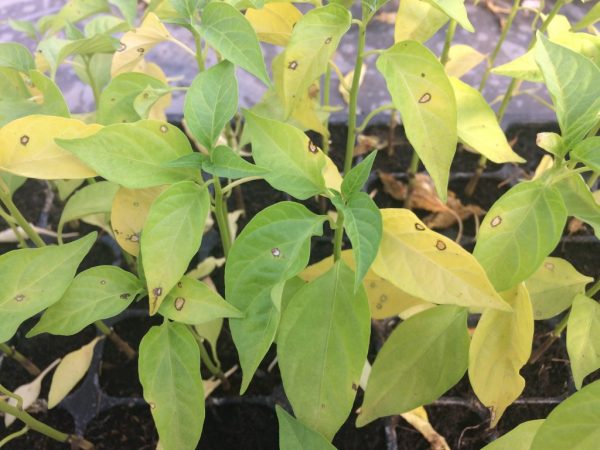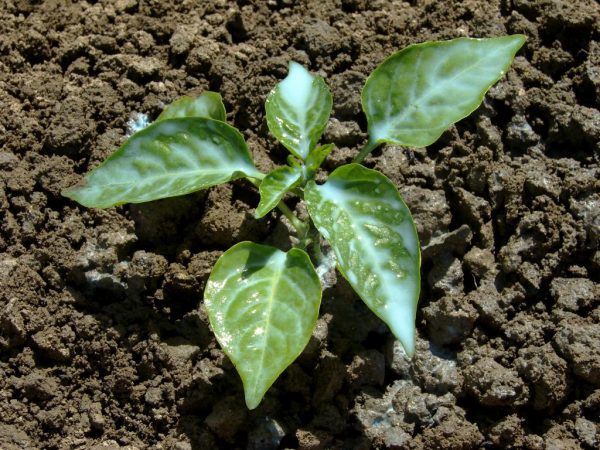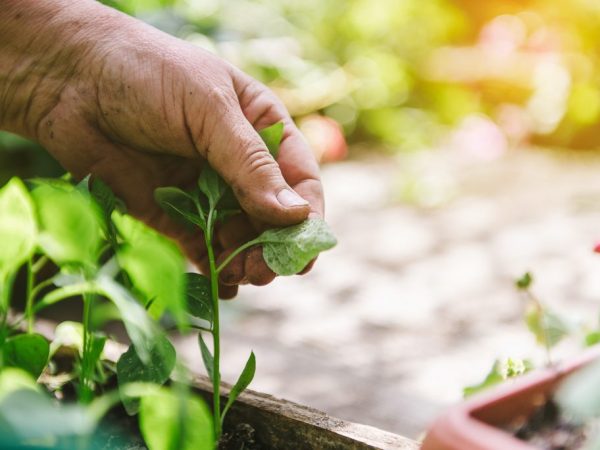We treat diseases of pepper seedlings
Bell pepper is a rather capricious culture. It belongs to those plants that have a very long growing season. Therefore, paprika is grown in a seedling way. The further development of vegetable crops depends on the quality of seedlings, therefore it is important to organize proper care for them. Diseases of pepper seedlings cause great harm to the culture. Consider how to avoid the problem and, if the disease affects the pepper, how to treat the culture.

Diseases of pepper seedlings
Types of diseases
The cultivation of paprika is associated with the appearance of various diseases on the sprouts. They can be combined into two groups:
- infectious;
- non-infectious.
Ignoring the signs of disease in pepper seedlings can lead to crop loss. Breeders are constantly working to create a variety that, along with high yields and excellent taste, will have high disease resistance.
Non-communicable diseases
Non-communicable diseases of pepper seedlings are not spread from one plant to another. The causes of such diseases are most often:
- mistakes in agricultural technology;
- non-compliance with the irrigation regime;
- lack or excess of light;
- violation of the temperature regime;
- lack or excess of nutrients.
Sunburn
On rather hot summer days, the plant is in direct sunlight for a long time. As a result, the culture becomes covered with whitish spots. Leaves wither.
Lack or excess of nitrogen
Lack of nitrogen causes yellowing of paprika leaves. They gradually dry out and fall off. Most of the ovaries can also crumble. An excess of nitrogen will lead to an increased build-up of green mass, but the fruits will stop growing.
Chlorosis
If in the stage of active growth the leaves of the seedlings turn yellow completely, the plant is affected by chlorosis. The main cause of the disease may be alkaline soil, iron deficiency or manganese deficiency.
The treatment of such diseases is reduced to correcting the mistakes made, organizing the correct care for the culture.
Infectious diseases

Ready-made preparations help
Infectious diseases are quite dangerous for pepper seedlings. Such diseases spread very quickly to all seedlings. The causative agents of infectious diseases are:
- pathogenic fungi;
- pathogenic bacteria;
- viruses.
For their treatment, special drugs should be used, some of the sprouts will have to be destroyed. Infectious diseases are easier to prevent than to save crops later.
The following hybrids are resistant to most infectious diseases: Agapovsky, Big Papa, Yellow Bell, Star of the East.
Fungal diseases
Pathogenic fungi live everywhere: in the soil, on tools.If you do not carry out preventive measures to disinfect the site, pepper seedlings will be constantly exposed to fungal diseases.
The most common diseases:
- blackleg;
- gray rot;
- late blight;
- fungal wilting.
Blackleg
The fact that the seedlings of fragrant peppers are sick with a black leg is evidenced by a change in the color of the base of the stem. At the same time, its thinning and softening occurs. This disease is a manifestation of the following gardeners' mistakes:
- The planting density is too high.
- Excess moisture.
- Failure to comply with the temperature regime.
Treatment
When the first signs of a black leg appear, the sprouts affected by the disease should be urgently removed. Treat the rest of the seedlings with special preparations. Among the ready-made formulations, Fitosporin has proven itself well. Dissolve 100 ml of the preparation in 10 liters of water. Spray or water the bell pepper seedlings with this solution.
Gardeners recommend preparing a solution based on copper sulfate. 10 liters. water is enough 1 teaspoon of vitriol and 1 cup of Bordeaux liquid, manganese solution or wood ash.
At the same time, normalize the conditions for the development of seedlings.
- To do this, create an optimal temperature regime. In the daytime, the first two weeks after the emergence of seedlings, the thermometer should not fall below 20 ° C, at night these indicators can drop to 15 ° C. Further normal development of seedlings occurs at temperatures up to 25 ° C during the day and 11 ° C at night.
- Adjust the frequency and amount of watering. Loose the soil. Do not water the seedlings if the temperature drops below the permissible level. If necessary, dry the soil with sand, mulch with wood ash.
Prophylaxis
To prevent the development of a black leg, take preventive measures. Before planting, treat the soil with 1% manganese solution, special solutions "Shining", "Baikal", "Trichodermin" and others. Soak paprika seeds in similar solutions before sowing. Use ready-made formulations strictly according to the manufacturer's instructions.
Gray rot

Defining the disease
Thin white films that appear in the root zone are one of the manifestations of gray rot. The disease can also manifest itself in the form of weeping brown spots, gradually becoming covered with a gray bloom.
The reason that the seedlings get sick is high humidity. If signs of disease are found, remove all damaged shoots, reduce watering, loosen the soil, ventilate the room.
You can process the planting of peppers with infusion of garlic, pollinate with chalk or activated carbon. To pollinate seedlings, crush chalk or charcoal tablets into dust, place the powder in cheesecloth and carry out the procedure.
Prepare an infusion of garlic from 100 gr. cloves, 50 ml of sunflower oil and 6 ml of liquid soap. Chop the garlic through a press, combine with the rest of the ingredients and leave to infuse for 24 hours. Prepare a solution for processing seedlings from 2 tablespoons of garlic concentrate and 1 liter. settled warm water. Spray the plants with the resulting composition.
Late blight
If individual brown spots appear on the stem and leaves of paprika, the culture is ill with late blight. Further development of the disease manifests itself in the fusion of all the spots into one large brown spot. The leaves begin to fall off. The reason for the development of such a disease is a high level of air humidity.
Treatment of late blight is as follows:
- Remove all diseased plants.
- Adjust the frequency and amount of watering.
- Dry, loosen the soil.
- Treat healthy plants with special preparations. For this, "Barrier", "Fitodoctor", "Previkur" are suitable. Use them strictly in accordance with the attached instructions.
Fungal wilting
There are two types of fungal wilting: Fusarium and Verticillium.Both diseases cannot be detected in the early stages. The first sign of fusarium and verticillosis is a sharp drop in leaves. After a while, the sweet pepper seedlings wither and die. If you cut the sprout, you can see that the inside of the stem is brown. This indicates that the vessels of the plant are blocked, metabolic processes are disturbed. As a result, the root system begins to rot, then the plant dies completely.
Fusarium and verticilliosis are incurable. Therefore, it is recommended to remove damaged plants. Treat healthy seedlings with solutions "Previkur", "Oksikhom".
As a preventive measure, the soil before planting bitter or sweet peppers should be treated with Planriz or 2% manganese solution.
Bacterial diseases

We do not delay treatment
Disease-causing bacteria appear under favorable conditions for them:
- high humidity;
- low air temperatures.
Bacterial infections of paprika attack the seedlings. The disease can manifest itself in the future at any stage of plant development. All types of spotting are caused by bacteria.
Signs of disease are the appearance on the underside of the leaf plate of small spots: from white with different shades of gray to black. The subsequent course of the disease is manifested in the merging of small separate spots into one large one. Leaves curl and fall off.
Prophylaxis
To prevent the appearance of spots, decontaminate the seed. A 1% manganese solution is suitable for this. Hold the seeds in it for 2-3 hours, then dry.
If the pepper seedlings have been spotted, remove the infected sprouts, disinfect the soil under the plants with a pink solution.
Viral diseases
Viral diseases include stolbur and tobacco mosaic. These diseases are carried by aphids, ticks. In order to prevent the development of viral diseases, gardeners should take measures against the appearance of insects in areas with pepper seedlings.
It is impossible to cure a vegetable crop from such diseases. Diseased sprouts are removed and burned. The soil is loosened, disinfected with special chemicals. The compositions "Zaslon" and "Barrier" are well recommended.
As a preventive measure, vegetable growers call disinfection of seeds, treatment with insecticides of the soil before planting pepper and sprouts after two real leaves appear on them.
The most common types of such diseases are stolbur and tobacco mosaic.
Pillar
It is possible to determine that spicy or sweet paprika is infected with the stolbur virus by the following signs:
- the seedlings of peppers have stopped growing;
- the color of the sprouts has changed to yellow;
- the leaves began to dry out and curl upward.
Today, there is practically not a single variety of vegetable crops that would have a high degree of resistance to the pillar.
Tobacco mosaic
Mosaic patterns appear on paprika leaves. They look like an interweaving of light and dark specks of green and yellow. Gradually, the leaf plates are deformed, blacken and fall off. The tobacco mosaic virus causes overheating of the culture.
Breeders managed to develop varieties that are highly resistant to tobacco mosaic. Among them are:
- Indalo;
- Cardinal;
- Sonata;
- Blondie;
- Fidelio.
Growing paprika is not an easy task. During the entire growing season, the culture is exposed to various diseases. Carefully monitor the seedlings, react in a timely manner to the signals of the bush. This is the only way you can get a healthy harvest.


